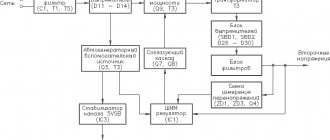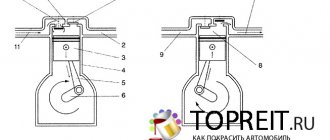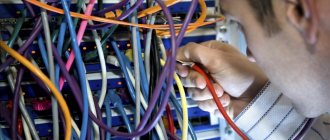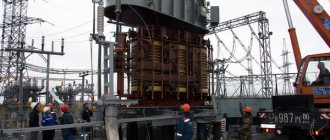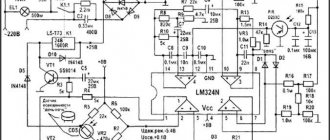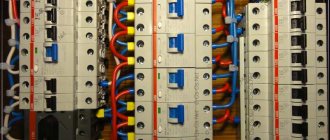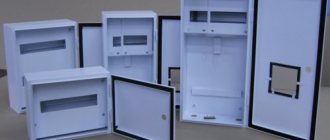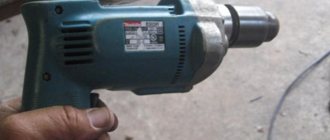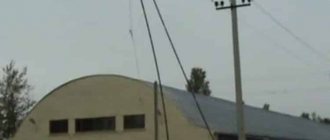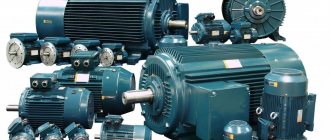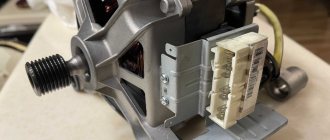Planning and preparation of repairs.
Planning of repairs of electric motors is carried out in accordance with the requirements of the “Rules for the technical operation of power plants and networks” (PTE) according to the system of scheduled preventive maintenance (PPR). Scheduled preventive maintenance includes a set of activities: maintenance and supervision during operation; periodic carrying out current and major repairs; carrying out preventive tests in accordance with the requirements of the “Electrical Equipment Testing Standards”. The frequency and timing of repairs of electric motors are linked to the repair of driven units. This helps reduce labor costs for aligning the unit with the engine, preparing the workplace by operating personnel, etc. The frequency of repairs is established by a schedule approved by the chief engineer of the enterprise. When planning the timing of major and current repairs, the technical condition of electric motors is taken into account, determined during operation (condition of bearings, heating of active parts, etc.). Annual repair schedules are drawn up by the electrical shop of the enterprise operating the electric motor and are agreed upon with the contractor performing the repair of electric motors. In accordance with the repair schedule, preparatory work is carried out, which includes: drawing up a work schedule indicating a list of devices necessary for repairing electric motors and the timing of their manufacture or delivery to the repair site; procurement of necessary materials and spare parts; preparation of fire and safety measures; development and coordination with adjacent workshops of a project for organizing special work. These works are performed by the personnel of the operating and contracting organizations. Before the electric motors are brought out for repair, all of the above preparatory work must be completed, the repair personnel must be staffed in teams, familiar with the scope of the upcoming work and the design features of the electric motors. Before starting work, the repair manager must familiarize himself with the reporting documentation on previously performed repairs on these electric motors, paying special attention to the results of previous repairs, the time spent by the bearings after replacing them and changing the lubricant, the value of air gaps and clearances in bearings, and test results . Notes on the operation of electric motors (overheating of the winding, active steel, vibration state, bearing temperature) must also be taken into account.
Maintenance
Timely maintenance will help avoid many problems in the future. The frequency of its implementation depends on the characteristics of external conditions and the units with which the electric motors operate.
Maintenance involves performing the following actions:
- Cleaning the installation from dust and dirt.
- Checking the motor holders and its components.
- Checking for defect-free grounding.
- Overheat control.
- Insulation resistance measurement.
- Condition of the electrical machine assembly and slip rings.
On average, maintenance is performed once every 2 months. For engines installed on grain crushing machines, presses and threshers, maintenance must be carried out even more often (once every 1.5 months).
Organization of workplaces for engine repair.
The most progressive form of repair maintenance of electric motors is centralized repair in workshops, industrial repair enterprises (PRP), equipped with the necessary equipment and accessories to perform all labor-intensive disassembly, assembly and repair operations. It is advisable to carry out any type of standard repair, which requires disconnecting the electric motor from the foundation and the unit, in a special workshop. Appropriate vehicles must be used to deliver electric motors to the workshop, and the workshop's lifting mechanisms must ensure their unloading. To carry out any type of repair using progressive methods that ensure high labor productivity and quality of repair, the workshop must be equipped with energy distribution (compressed air, water supply, power supply at various voltages) and include: a chamber for pneumohydraulic cleaning of electric motors, an installation for washing parts, a paint shop and drying chamber, stocks for disassembling electric motors with a vertical shaft, tilters for stators, stands for stators, stands for installing and turning rotors, a machine for balancing rotors, a machine for making groove wedges, drilling and sharpening machines, a set of pullers (hydraulic and screw) , a set of devices for removing sections of stator windings of electric motors, racks for placing components and parts when disassembling electric motors and workbenches for repairing components and parts of electric motors. When performing restoration repairs of electric motors in a workshop, in addition to the above equipment, it should include: a chamber for annealing loose windings, an installation for extracting loose windings, winding machines, an impregnation bath and an installation for filling sliding bearings. It is advisable to manufacture reserve coils for stator windings of high-voltage electric motors with micalent and other insulation at large bases that have compounding equipment, which helps ensure high quality and increase service life. In the absence of workshops for centralized repair of electric motors, repair sites can be organized. By “repair site” we mean a free area intended for reloading operations and placement of assembly units and equipment parts, repair devices and equipment during major repairs, as well as for performing repair operations that, according to technology, must be carried out near the equipment being repaired. Repair sites must be equipped with power distribution and be located within the range of the lifting equipment. Energy distributions mean distributions of oxygen, acetylene, compressed air with a pressure of (4-6)10® Pa and technical water with a pressure of 4X XY5 Pa, as well as a stationary electrical network with a voltage of 380/220 V to ensure electric welding work, connecting power tools through a frequency converter with a voltage of 36 V (220 Hz) and portable lamps through a 220/12 V transformer. The repair site must have general and local electric lighting.
Safety rules during maintenance
Before carrying out maintenance of any complexity, it is necessary to ensure the safety of operating personnel. All maintenance work (except for checking operating conditions) is carried out with complete removal of voltage from the equipment.
The direct executor must ensure that spontaneous or erroneous supply of voltage to the serviced electric motor is blocked. To do this, it is necessary to block the voltage supply, and hang a poster on the lever of the switching mechanism: “Do not turn on, people are working!”
Laboratory work No. 6 “The procedure for organizing the repair of electrical machines”
Purpose of work: To study the procedure for organizing the repair of electrical machines.
Planning of repairs of electric motors is carried out in accordance with the requirements of the “Rules for the technical operation of power plants and networks” (PTE) according to the system of scheduled preventive maintenance (PPR). Scheduled preventive maintenance includes a set of activities: maintenance and supervision during operation; periodic carrying out current and major repairs; carrying out preventive tests in accordance with the requirements of the “Electrical Equipment Testing Standards”. The frequency and timing of repairs of electric motors are linked to the repair of driven units. This helps reduce labor costs for aligning the unit with the engine, preparing the workplace by operating personnel, etc. The frequency of repairs is established by a schedule approved by the chief engineer of the enterprise. When planning the timing of major and current repairs, the technical condition of electric motors is taken into account, determined during operation (condition of bearings, heating of active parts, etc.). Annual repair schedules are drawn up by the electrical shop of the enterprise operating the electric motor and are agreed upon with the contractor performing the repair of electric motors. In accordance with the repair schedule, preparatory work is carried out, which includes: drawing up a work schedule indicating a list of devices necessary for repairing electric motors and the timing of their manufacture or delivery to the repair site; procurement of necessary materials and spare parts; preparation of fire and safety measures; development and coordination with adjacent workshops of a project for organizing special work. These works are performed by the personnel of the operating and contracting organizations. Before the electric motors are brought out for repair, all of the above preparatory work must be completed, the repair personnel must be staffed in teams, familiar with the scope of the upcoming work and the design features of the electric motors. Before starting work, the repair manager must familiarize himself with the reporting documentation on previously performed repairs on these electric motors, paying special attention to the results of previous repairs, the time spent by the bearings after replacing them and changing the lubricant, the value of air gaps and clearances in bearings, and test results . Notes on the operation of electric motors (overheating of the winding, active steel, vibration state, bearing temperature) must also be taken into account.
Organization of workplaces for engine repair.
The most progressive form of repair maintenance of electric motors is centralized repair in workshops, industrial repair enterprises (PRP), equipped with the necessary equipment and accessories to perform all labor-intensive disassembly, assembly and repair operations. It is advisable to carry out any type of standard repair, which requires disconnecting the electric motor from the foundation and the unit, in a special workshop. Appropriate vehicles must be used to deliver electric motors to the workshop, and the workshop's lifting mechanisms must ensure their unloading. To carry out any type of repair using progressive methods that ensure high labor productivity and quality of repair, the workshop must be equipped with energy distribution (compressed air, water supply, power supply at various voltages) and include: a chamber for pneumohydraulic cleaning of electric motors, an installation for washing parts, a paint shop and drying chamber, stocks for disassembling electric motors with a vertical shaft, tilters for stators, stands for stators, stands for installing and turning rotors, a machine for balancing rotors, a machine for making groove wedges, drilling and sharpening machines, a set of pullers (hydraulic and screw) , a set of devices for removing sections of stator windings of electric motors, racks for placing components and parts when disassembling electric motors and workbenches for repairing components and parts of electric motors. When performing restoration repairs of electric motors in a workshop, in addition to the above equipment, it should include: a chamber for annealing loose windings, an installation for extracting loose windings, winding machines, an impregnation bath and an installation for filling sliding bearings. It is advisable to manufacture reserve coils for stator windings of high-voltage electric motors with micalent and other insulation at large bases that have compounding equipment, which helps ensure high quality and increase service life. In the absence of workshops for centralized repair of electric motors, repair sites can be organized. By “repair site” we mean a free area intended for reloading operations and placement of assembly units and equipment parts, repair devices and equipment during major repairs, as well as for performing repair operations that, according to technology, must be carried out near the equipment being repaired. Repair sites must be equipped with power distribution and be located within the range of the lifting equipment. Energy distributions mean distributions of oxygen, acetylene, compressed air with a pressure of (4-6)10® Pa and technical water with a pressure of 4X XY5 Pa, as well as a stationary electrical network with a voltage of 380/220 V to ensure electric welding work, connecting power tools through a frequency converter with a voltage of 36 V (220 Hz) and portable lamps through a 220/12 V transformer. The repair site must have general and local electric lighting.
